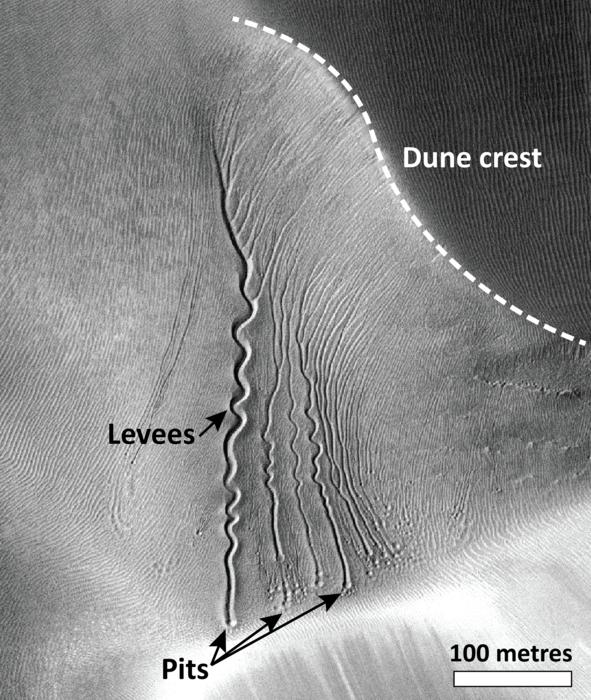Strange trenches meander across Mars like hastily left signatures. A recent study headed by Utrecht University reveals that chunks of CO2 ice can create these gullies by propelling sand aside with vaporized gas, rather than liquid water. In laboratory experiments conducted under Martian air pressure, researchers replicated both straight and winding channels with pit-like endings that correspond to actual features captured by NASA’s HiRISE camera.
This research centers on what are known as linear dune gullies that aggregate in the southern mid-latitudes of Mars. For years, some scientists connected these channels to wet debris flows during warmer periods. That notion carried significant implications for habitability. However, high-resolution monitoring has indicated that the gullies become active in late winter and spring, coinciding with the formation and subsequent disappearance of seasonal CO2 frost. The latest experiments complete the picture by demonstrating how CO2 blocks can slide or burrow down the slope, forming the same distinct ridges and pits seen on Martian dunes.
Imagine a steep sand slope within a Mars chamber. The team dropped CO2 ice blocks onto the sand and recorded the results with high-speed cameras. On steeper inclines, the blocks skimmed quickly, creating shallow grooves with faint levees. On gentler slopes, the dynamics shifted. Sublimating gas created pressure beneath the ice, fluidizing the sand and ejecting grains ballistically. The block then nestled into the surface and progressed forward while digging deep channels bordered by tall levees. Viewed from above, some trails kinked and curled as tiny ripple-like bumps nudged the block off course, closely resembling the unusual bends observed on Mars.
“The CO2 ice block started to penetrate the slope and move downward much like a burrowing mole or the sandworms from Dune.”
That description is not a metaphor layered onto theory. It is precisely what the cameras recorded, under pressures comparable to Mars’s thin atmosphere. The team also modeled how far ejected grains should travel under Martian gravity. The trajectories correlate with levee widths and channel depths measured on Russell crater’s megadune, where HiRISE images have even captured stranded ice blocks at the gully ends. The narrative that emerges is a two-mode mechanism: sliding at the top, burrowing below, followed by a final stationary phase that carves a terminal pit as the last ice vanishes.
## From Winter Frost To Burrowing Blocks
Here is the proposed cycle. In the southern winter, a layer of CO2 frost envelopes dune fields, sometimes up to 70 centimeters thick. As spring sunlight warms the slopes, patches thaw unevenly. Blocks break free from shaded summits and begin to move. On steep faces, they glide and scratch the surface. As the gradient eases, the blocks decelerate, gas out, and dig. Burrowing is slow yet powerful, a sand thrower that constructs levees grain by grain. When the block reaches the base and halts, sublimation continues until only a pit is left.
The team emphasizes the significance of grain size. Fine, well-sorted sand encouraged burrowing in the chamber. Coarser, poorly-sorted sand favored sliding or caused stalls. This constraint may clarify why linear dune gullies do not appear on every slope experiencing seasonal CO2. It also suggests that these landforms reflect microclimate and material properties, rather than just a single global mechanism.
“In our simulation, I observed how this high gas pressure blasts away the sand around the block in all directions.”
That quote highlights the crucial factor. Mars’s atmosphere is near 700 pascals. At such low pressure, converting cold CO2 ice to gas generates strong outflows relative to Earth. These outflows can transport sand sufficiently to build the characteristic levees. It is an elegant argument because it does not involve liquid water at any step. Sinuosity is not evidence of fluid flow. It can result from a burrowing solid that reacts to minor bumps and temperature variations along the slope.
## Why It Matters For Mars, And For Us
The finding diminishes the likelihood of recent liquid water in these specific gullies. This does not eliminate the possibility of water elsewhere or at different times. It does encourage caution when interpreting curvy channels on icy worlds. Future missions that capture images of dunes on Europa or Titan might reveal similar patterns. If they do, this study provides a physics-based benchmark before considering melt.
I acknowledge a quiet satisfaction in how unromantic mechanics can still evoke wonder. A white block hisses, sand leaps like sparks, and a trench expands. On the HiRISE image of Matara crater, one can trace those trenches like dark stitches across a pale slope, each concluding in a neat, round pit. Life did not carve them. But physics certainly did, with flair.
[Geophysical Research Letters: 10.1029/2024GL112860](https://doi.org/10.1029/2024GL112860)
**There’s no paywall here**
*If our reporting has informed or inspired you, please consider making a donation. Every contribution, no
